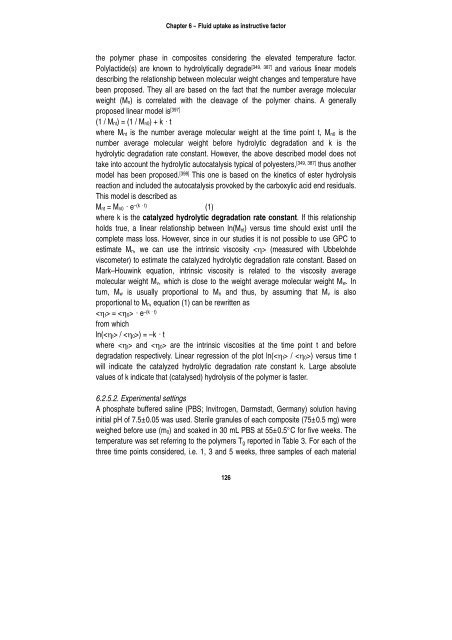Barbieri Thesis - BioMedical Materials program (BMM)
Barbieri Thesis - BioMedical Materials program (BMM)
Barbieri Thesis - BioMedical Materials program (BMM)
Create successful ePaper yourself
Turn your PDF publications into a flip-book with our unique Google optimized e-Paper software.
Chapter 6 – Fluid uptake as instructive factor<br />
the polymer phase in composites considering the elevated temperature factor.<br />
Polylactide(s) are known to hydrolytically degrade [349, 387] and various linear models<br />
describing the relationship between molecular weight changes and temperature have<br />
been proposed. They all are based on the fact that the number average molecular<br />
weight (Mn) is correlated with the cleavage of the polymer chains. A generally<br />
proposed linear model is [397]<br />
(1 / Mnt) = (1 / Mn0) + k · t<br />
where Mnt is the number average molecular weight at the time point t, Mn0 is the<br />
number average molecular weight before hydrolytic degradation and k is the<br />
hydrolytic degradation rate constant. However, the above described model does not<br />
take into account the hydrolytic autocatalysis typical of polyesters, [349, 387] thus another<br />
model has been proposed. [398] This one is based on the kinetics of ester hydrolysis<br />
reaction and included the autocatalysis provoked by the carboxylic acid end residuals.<br />
This model is described as<br />
Mnt = Mn0 · e –(k · t) (1)<br />
where k is the catalyzed hydrolytic degradation rate constant. If this relationship<br />
holds true, a linear relationship between ln(Mnt) versus time should exist until the<br />
complete mass loss. However, since in our studies it is not possible to use GPC to<br />
estimate Mn, we can use the intrinsic viscosity (measured with Ubbelohde<br />
viscometer) to estimate the catalyzed hydrolytic degradation rate constant. Based on<br />
Mark–Houwink equation, intrinsic viscosity is related to the viscosity average<br />
molecular weight Mv, which is close to the weight average molecular weight Mw. In<br />
turn, Mw is usually proportional to Mn and thus, by assuming that Mv is also<br />
proportional to Mn, equation (1) can be rewritten as<br />
= · e –(k · t)<br />
from which<br />
ln( / ) = –k · t<br />
where and are the intrinsic viscosities at the time point t and before<br />
degradation respectively. Linear regression of the plot ln( / ) versus time t<br />
will indicate the catalyzed hydrolytic degradation rate constant k. Large absolute<br />
values of k indicate that (catalysed) hydrolysis of the polymer is faster.<br />
6.2.5.2. Experimental settings<br />
A phosphate buffered saline (PBS; Invitrogen, Darmstadt, Germany) solution having<br />
initial pH of 7.5±0.05 was used. Sterile granules of each composite (75±0.5 mg) were<br />
weighed before use (m0) and soaked in 30 mL PBS at 55±0.5°C for five weeks. The<br />
temperature was set referring to the polymers Tg reported in Table 3. For each of the<br />
three time points considered, i.e. 1, 3 and 5 weeks, three samples of each material<br />
126





